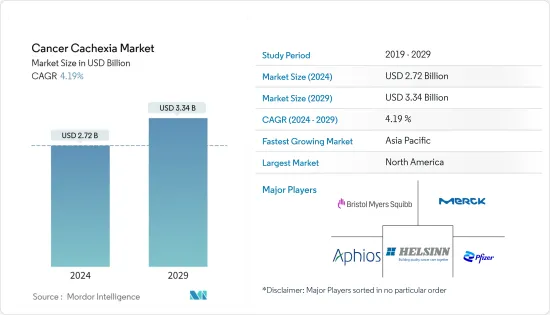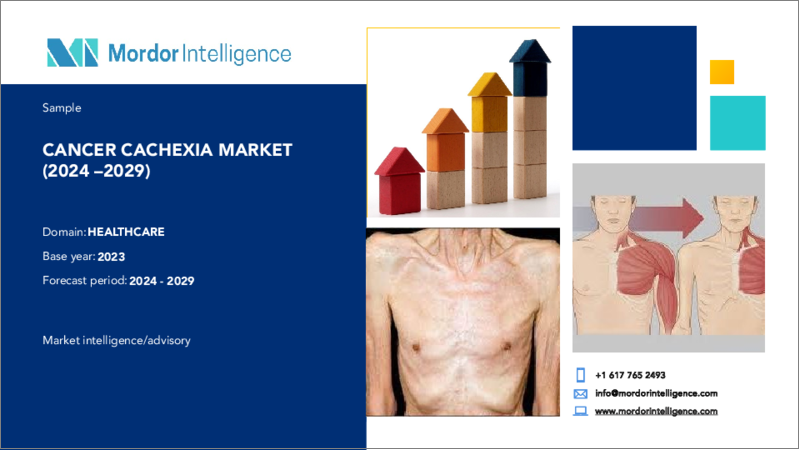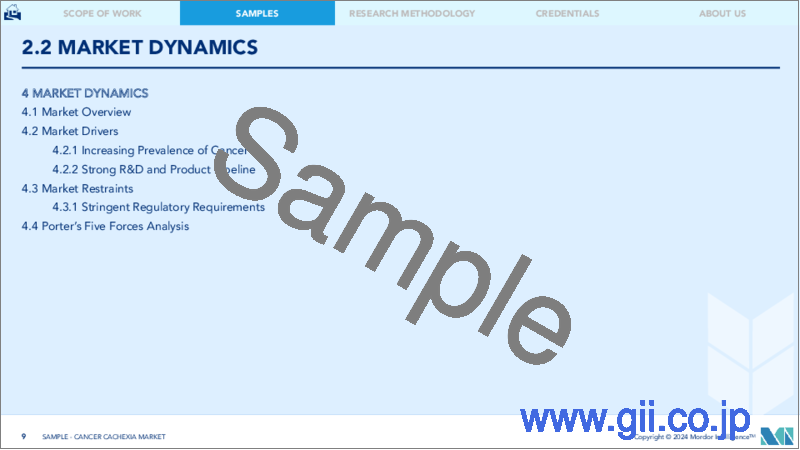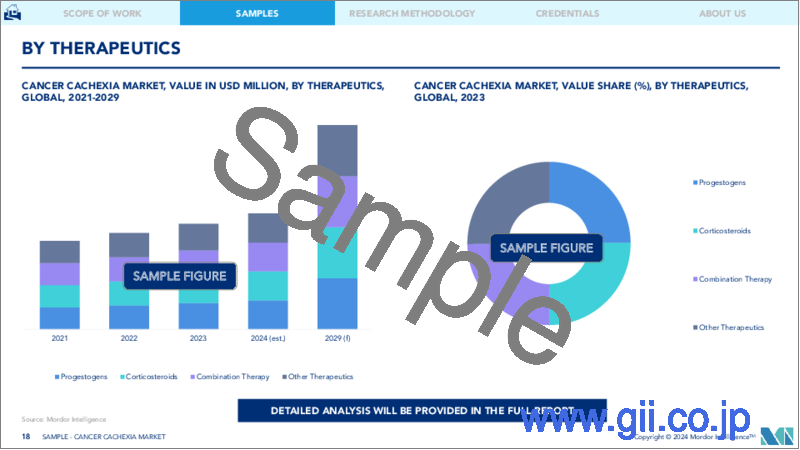|
|
市場調査レポート
商品コード
1438283
がん悪液質:市場シェア分析、業界動向と統計、成長予測(2024~2029年)Cancer Cachexia - Market Share Analysis, Industry Trends & Statistics, Growth Forecasts (2024 - 2029) |
||||||
カスタマイズ可能
適宜更新あり
|
|||||||
| がん悪液質:市場シェア分析、業界動向と統計、成長予測(2024~2029年) |
|
出版日: 2024年02月15日
発行: Mordor Intelligence
ページ情報: 英文 115 Pages
納期: 2~3営業日
|
全表示
- 概要
- 目次
がん悪液質の市場規模は、2024年に27億2,000万米ドルと推定され、2029年までに33億4,000万米ドルに達すると予測されており、予測期間(2024年から2029年)中に4.19%のCAGRで成長します。

新型コロナウイルス感染症(COVID-19)の発生は、世界的に実施された社会的距離措置により病院やヘルスケアサービスが大幅に縮小されたため、がん悪液質市場に影響を与えました。新型コロナウイルス感染症(COVID-19)のパンデミックは世界経済にも影響を及ぼし、世界中の病院における新型コロナウイルス感染症以外の患者に対する一般的な病院医療にも影響を与えました。 2020年にBritish Journal of Nutritionに掲載された調査論文によると、入院中の栄養状態の変化と体重減少が一部の集団で主に報告されています。ただし、COVID-19患者では完全には調査されていませんでした。パンデミック中、COVID-19の症状と関連症状により栄養状態が悪化し、悪液質が生じました。がん患者は免疫力が低下しており、感染と戦う能力が他の人に比べて非常に低いため、COVID-19感染症に感染するリスクが高くなりました。さらに、がん患者がCOVID-19感染症を発症した場合、多臓器関連の合併症や悪液質を発症する可能性が高くなります。したがって、COVID-19感染症のパンデミックは初期段階では市場に大きな影響を与えましたが、現在、COVID-19が沈静化しているため、市場は予測期間中に良好な成長を遂げると予想されています。
がんおよびがん悪液質の有病率の増加と、がん悪液質の治療における新しい治療法を開発するための研究開発活動への投資の増加が、市場を牽引する主な要因です。
世界のがんの負担は増加しています。したがって、がん治療は地域および国家の優先順位に応じて変更する必要があります。 2020年12月の国際がん調査機関(IARC)によると、世界では5人に1人が生涯のうちにがんを発症し、男性の8人に1人、女性の11人に1人ががんにより死亡しています。 2022年 2月にWHOが発表したデータによると、毎年約40万人の子供ががんを発症しており、最も一般的ながんは国によって異なります。子宮頸がんは23か国で最も一般的です。したがって、世界中でがんの負担が増大することにより、がん患者の間でがん悪液質の有病率も増加します。がん悪液質は、全身性の炎症、タンパク質とエネルギーのバランスの低下、除脂肪体重の非自発的な減少を特徴とします。
この要因により、主要企業のほとんどは、がん悪液質の治療において非常に効果的な新薬を開発するための研究開発活動に焦点を当てています。この要因により、承認を待っている治療薬のパイプラインと承認後の商業発売が増加しました。たとえば、clinicaltrials.govは、2022年 10月の時点で、がん悪液質を治療する薬を開発するために合計 150件の研究が実施された、または実施中であると報告しました。 2020年12月、コペンハーゲン大学がジーランド大学病院と協力して臨床研究を開始し、オキサリプラチンまたはパクリタキセルベースの化学療法を受けている患者の除脂肪体重(悪液質)に対する医療用カンナビジオールの影響をモニタリングする研究が行われました。さらに、2021年1月にはヘルシングループと小野薬品工業が日本におけるAdlumizの製造販売承認を取得しました。これは、非小細胞肺がん、胃がん、膵臓がん、または結腸直腸がんの悪性腫瘍におけるがん悪液質を治療するグレリン受容体作動薬です。したがって、がん悪液質に対する研究開発活動の増加が、がん悪液質の成長を促進すると予想されています。市場。
しかし、がん悪液質治療薬のメーカーは、厳しい規制要件とFDAの承認手続きに時間がかかるため、市場への投資を躊躇しており、この市場の長期的な成長を妨げる可能性があります。
がん悪液質の市場動向
食欲刺激剤はがん悪液質市場で大幅な成長が見込まれる
がん患者は、食欲不振や体重減少を頻繁に起こします。がん患者における意図しない体重減少や食欲不振(食欲や食べたいという欲求の喪失)は、パフォーマンスステータスの低下、治療に対する反応や耐性の低下、生存率の低下、生活の質の低下と関連しています。したがって、食欲が低下している患者に対しては、食欲増進剤の使用を増やすことが検討される可能性があります。がん悪液質の有病率の増加は、市場全体の成長を推進する主要な要因の1つです。
PubMedが2022年3月に発表した論文によると、がん関連の食欲不振に対する薬理学的介入は非常に限られています。国際ガイドラインでは、栄養療法、理学療法、薬理学的療法に役立つ食欲刺激剤による同化作用の促進を推奨しています。 PubMed Centralが2021年8月に発表した論文によると、悪液質は、脂肪組織の損失の有無にかかわらず、炎症と筋肉の損失を特徴とする代謝障害の症候群です。多面的な症状であるがん悪液質では、患者は体重と食欲の低下に苦しみ、患者の生活の質と生存に悪影響を及ぼします。したがって、患者の生活の質におけるがん悪液質の負担が大きいことから、がん悪液質に対する食欲刺激剤に関する研究開発活動が増加し、このセグメントの成長が促進されると予想されます。
世界中でがんの負担が増大する中、市場関係者は革新的な製品とその研究開発に着実に投資しており、市場の成長を押し上げています。たとえば、2020年3月、世界の製薬大手ファイザー社は、同社の薬剤PF-06946860ががん悪液質患者においてどのように忍容されるかを調査する世界の12週間の非盲検試験を開始しました。したがって、このような要因は、食欲刺激剤セグメントが将来的に高い成長率を達成するのに役立つ可能性があります。
北米ががん悪液質市場を独占すると予想される
がんおよびがん悪液質の負担が大きいこと、多くの製薬会社が存在すること、がん患者の治療パラダイムが進歩していることなどから、北米が市場を独占すると予想されています。 GLOBOCAN 2020の推計によると、メキシコでは約195,499人の新規がん患者が発生しています。さらに、米国がん協会2022によると、2022年に米国で新たにがんと診断される患者数は推定190万人になると予想されています。
がん悪液質治療のための新しい技術の進歩と消耗症候群のための強力な製品パイプラインも、この地域のがん悪液質市場の成長に貢献しています。たとえば、2022年10月のclinicaltrials.govのデータによると、第1相臨床試験は2022年2月に米国に拠点を置くAVEO Pharmaceuticals, Inc.によって開始され、この研究は安全性と薬物動態(PK)を評価するように設計されています。、AV-380の単回投与の健康な対象者における薬力学(PD)、および免疫原性。 AV-380は、がん誘発性悪液質に関与するサイトカインである循環ヒト成長分化因子 15(GDF-15)に結合することを目的とした免疫グロブリン(Ig)G1モノクローナル抗体(mAb)です。したがって、このような要因により、この地域の市場は成長すると予想されます。
がん悪液質業界の概要
がん悪液質市場は、世界的にも地域的にも事業を展開している大手企業がほとんど存在しないため、本質的に統合されています。競合情勢には、市場シェアを保持し、よく知られている数社の国際企業と地元企業の分析が含まれています。主要な市場プレーヤーには、Aeterna Zentaris、Aphios Corporation、Bristol-Myers Squibb Company、Pfizer Inc.、Helsinn Group、Merck KGaA、Artelo Biosciences Inc.、NGM Biopharmaceuticals、Aveo Oncology、Aavogen Inc.、Green Cross Wellbeing Corporation、Cannabics Pharmaceuticals Inc.が含まれます。、TCI Peptide Therapeutics、Fresenius Kabi、Tetra Bio-Pharma、Actimed Therapeuticsなどがあります。
その他の特典
- エクセル形式の市場予測(ME)シート
- 3か月のアナリストサポート
目次
第1章 イントロダクション
- 調査の成果
- 調査の前提条件
- 調査範囲
第2章 調査手法
第3章 エグゼクティブサマリー
第4章 市場力学
- 市場概要
- 市場促進要因
- がん悪液質の有病率の増加
- 強力な研究開発と製品パイプライン
- 市場抑制要因
- 厳しい規制要件
- ポーターのファイブフォース分析
- 新規参入業者の脅威
- 買い手の交渉力
- 供給企業の交渉力
- 代替製品の脅威
- 競争企業間の敵対関係の激しさ
第5章 市場セグメンテーション
- 治療法別
- プロゲストーゲン
- コルチコステロイド
- 併用療法
- その他の治療法
- 作用機序別
- 食欲刺激剤
- 減量安定剤
- 地域別
- 北米
- 米国
- カナダ
- メキシコ
- 欧州
- ドイツ
- 英国
- フランス
- イタリア
- スペイン
- その他欧州
- アジア太平洋
- 中国
- 日本
- インド
- オーストラリア
- 韓国
- その他アジア太平洋地域
- 中東とアフリカ
- GCC
- 南アフリカ
- その他中東およびアフリカ
- 南米
- ブラジル
- アルゼンチン
- その他南米
- 北米
第6章 競合情勢
- 企業プロファイル
- Aeterna Zentaris
- Aphios Corporation
- Bristol-Myers Squibb Company
- Pfizer Inc.
- Helsinn Group
- Merck KGaA
- Artelo Biosciences Inc.
- NGM Biopharmaceuticals
- Aveo Oncology
- Aavogen Inc.
- Green Cross Wellbeing Corporation
- Cannabics Pharmaceuticals Inc.
- TCI Peptide Therapeutics
- Fresenius Kabi
- Tetra Bio-Pharma
- Actimed Therapeutics
第7章 市場機会と将来の動向
The Cancer Cachexia Market size is estimated at USD 2.72 billion in 2024, and is expected to reach USD 3.34 billion by 2029, growing at a CAGR of 4.19% during the forecast period (2024-2029).

The COVID-19 outbreak impacted the cancer cachexia market, as hospitals and healthcare services were significantly reduced due to social distancing measures enforced globally. The COVID-19 pandemic also affected the global economy and impacted general hospital care for non-COVID-19 patients in hospitals worldwide. According to a research article published in the British Journal of Nutrition, 2020, changes in nutritional status and weight loss during hospitalization are largely reported in some populations. However, it was not completely explored in COVID-19 patients. During the pandemic, the symptoms and associated conditions of COVID-19 deteriorated nutritional status, leading to cachexia. Cancer patients were at a higher risk of being infected with COVID-19, as they are immunocompromised, and their ability to fight against the infection was very low compared to other individuals. Additionally, if a cancer patient developed a COVID-19 infection, there were higher chances of developing multiple organ-related complications or cachexia. Hence, the COVID-19 pandemic affected the market significantly in it's preliminary phase, however currently the market is expected to have a favorable growth in the forecast period as the COVID-19 has subsided.
The increasing prevalence of cancer and cancer cachexia cases and the increasing investment in the R&D activities for developing novel therapeutics in the treatment of cancer cachexia are the major factors driving the market.
The global cancer burden is increasing. Thus, cancer therapies must be modified according to regional and national priorities. According to the International Agency for Research on Cancer (IARC) in December 2020, globally, 1 in 5 people develop cancer during their lifetime, and 1 in 8 men and 1 in 11 women die from the disease. According to the data published by WHO in February 2022, approximately 400,000 children develop cancer every year and the most common cancers vary between countries. Cervical cancer is the most common in 23 countries. Hence, the increasing burden of cancers worldwide also increases the prevalence of cancer cachexia among cancer patients, which is characterized by systemic inflammation, negative protein and energy balance, and an involuntary loss of lean body mass.
Due to this factor, most of the major players are focused on R&D activities to develop highly effective novel drugs in the treatment of cancer cachexia. This factor resulted in an increased pipeline of therapeutics waiting for approval and commercial launch post-approval. For instance, clinicaltrials.gov reported that, as of October 2022, a total of 150 studies were conducted or were being conducted to develop drugs that treat cancer cachexia. In December 2020, a clinical study was initiated by University of Copenhagen, in collaboration with Zealand University Hospital, the study was conducted to monitor the effect of medical cannabidiol on lean body mass (cachexia) in patients receiving Oxaliplatin- or Paclitaxel-based chemotherapy. Moreover, in January 2021, Helsinn Group and Ono Pharmaceutical Co. Ltd received the manufacturing and marketing approval of Adlumiz in Japan. It is a ghrelin receptor agonist to treat cancer cachexia in malignant tumors of non-small cell lung cancer, gastric cancer, pancreatic cancer, or colorectal cancer.Hence, the increasing research and development activities for cancer cachexia is expected to drive the growth of the market.
However, manufacturers of cancer cachexia drugs are discouraged from investing in the market because of the strict regulatory requirements and the long FDA approval procedure, which may impede the long-term growth of this market.
Cancer Cachexia Market Trends
Appetite Stimulators is Expected to Grow Significantly in the Cancer Cachexia Market
Cancer patients frequently develop loss of appetite and weight loss. Unintended weight loss and anorexia (the loss of appetite or desire to eat) in patients with cancer is associated with decreased performance status, reduced response and tolerance to treatment, decreased survival, and reduced quality of life. Therefore, the increasing use of an appetite stimulant could be considered for patients who exhibit decreased appetite. The increasing prevalence of cancer cachexia cases is one of the major factors propelling the overall market's growth.
According to an article published by PubMed in March 2022, pharmacologic interventions for cancer-related anorexia are very limited. International guidelines recommend promoting anabolism through appetite stimulants which help in nutritional, physical, and pharmacologic therapies. According to an article published by PubMed Central in August 2021, cachexia is a syndrome of metabolic disturbance characterised by inflammation and loss of muscle with or without loss of adipose tissue. In cancer cachexia, a multifaceted condition, patients suffer from loss of body weight and appetite that negatively impact the quality of life and survival of the patients. Thus, the high burden of cancer cachexia in quality of life of the patients is expected to increase the research and development activities regarding appetite stimulators for cancer cachexia, thus enhancing the segment growth.
With the growing burden of cancer worldwide, market players are investing steadily in innovative products and their R&D, thus boosting the market's growth. For instance, in March 2020, Pfizer Inc., a global pharmaceutical major, launched a global 12-week open-label study that will explore how its drug, PF-06946860, is tolerated in patients with cancer cachexia. Hence, such factors may help the appetite stimulators segment achieve a high growth rate in the future.
North America is Expected to Dominate the Cancer Cachexia Market
North America is expected to dominate the market due to the high burden of cancer and cancer cachexia, the presence of many drug manufacturers, and the advancing paradigm of care for cancer patients. According to the estimates of GLOBOCAN 2020, there are around 195,499 new cases of cancer in Mexico. Furthermore, according to the American Cancer Society 2022, there will be an estimated 1.9 million new cancer cases diagnosed in the United States in 2022.
Advancements in novel technology for the treatment of cancer cachexia and a strong product pipeline for wasting syndrome have also helped in the growth of the cancer cachexia market in the region. For instance, according to the data from clinicaltrials.gov in October 2022, a phase 1 clinical trial was started by the United States-based AVEO Pharmaceuticals, Inc. in February 2022, the study is designed to evaluate the safety, pharmacokinetics (PK), pharmacodynamics (PD), and immunogenicity in healthy subjects of a single dose of AV-380. AV-380 is an immunoglobulin (Ig) G1 monoclonal antibody (mAb) intended to bind circulating human growth differentiation factor 15 (GDF-15), a cytokine involved in cancer-induced cachexia. Hence, due to such factors, the market is expected to grow in the region.
Cancer Cachexia Industry Overview
The cancer cachexia market is consolidated in nature due to the presence of very few major companies operating globally as well as regionally. The competitive landscape includes an analysis of a few international as well as local companies which hold market shares and are well known. Key market players include Aeterna Zentaris, Aphios Corporation, Bristol-Myers Squibb Company, Pfizer Inc., Helsinn Group, Merck KGaA, Artelo Biosciences Inc., NGM Biopharmaceuticals, Aveo Oncology, Aavogen Inc., Green Cross Wellbeing Corporation, Cannabics Pharmaceuticals Inc., TCI Peptide Therapeutics, Fresenius Kabi, Tetra Bio-Pharma, and Actimed Therapeutics among others.
Additional Benefits:
- The market estimate (ME) sheet in Excel format
- 3 months of analyst support
TABLE OF CONTENTS
1 INTRODUCTION
- 1.1 Study Deliverables
- 1.2 Study Assumptions
- 1.3 Scope of the Study
2 RESEARCH METHODOLOGY
3 EXECUTIVE SUMMARY
4 MARKET DYNAMICS
- 4.1 Market Overview
- 4.2 Market Drivers
- 4.2.1 Increasing Prevalence of Cancer Cachexia
- 4.2.2 Strong R&D and Product Pipeline
- 4.3 Market Restraints
- 4.3.1 Stringent Regulatory Requirements
- 4.4 Porter's Five Forces Analysis
- 4.4.1 Threat of New Entrants
- 4.4.2 Bargaining Power of Buyers/Consumers
- 4.4.3 Bargaining Power of Suppliers
- 4.4.4 Threat of Substitute Products
- 4.4.5 Intensity of Competitive Rivalry
5 MARKET SEGMENTATION (Market Size by Value - USD million)
- 5.1 By Therapeutics
- 5.1.1 Progestogens
- 5.1.2 Corticosteroids
- 5.1.3 Combination Therapy
- 5.1.4 Other Therapeutics
- 5.2 By Mechanism of Action
- 5.2.1 Appetite Stimulators
- 5.2.2 Weight Loss Stabilizers
- 5.3 By Geography
- 5.3.1 North America
- 5.3.1.1 United States
- 5.3.1.2 Canada
- 5.3.1.3 Mexico
- 5.3.2 Europe
- 5.3.2.1 Germany
- 5.3.2.2 United Kingdom
- 5.3.2.3 France
- 5.3.2.4 Italy
- 5.3.2.5 Spain
- 5.3.2.6 Rest of Europe
- 5.3.3 Asia-Pacific
- 5.3.3.1 China
- 5.3.3.2 Japan
- 5.3.3.3 India
- 5.3.3.4 Australia
- 5.3.3.5 South Korea
- 5.3.3.6 Rest of Asia-Pacific
- 5.3.4 Middle-East and Africa
- 5.3.4.1 GCC
- 5.3.4.2 South Africa
- 5.3.4.3 Rest of Middle-East and Africa
- 5.3.5 South America
- 5.3.5.1 Brazil
- 5.3.5.2 Argentina
- 5.3.5.3 Rest of South America
- 5.3.1 North America
6 COMPETITIVE LANDSCAPE
- 6.1 Company Profiles
- 6.1.1 Aeterna Zentaris
- 6.1.2 Aphios Corporation
- 6.1.3 Bristol-Myers Squibb Company
- 6.1.4 Pfizer Inc.
- 6.1.5 Helsinn Group
- 6.1.6 Merck KGaA
- 6.1.7 Artelo Biosciences Inc.
- 6.1.8 NGM Biopharmaceuticals
- 6.1.9 Aveo Oncology
- 6.1.10 Aavogen Inc.
- 6.1.11 Green Cross Wellbeing Corporation
- 6.1.12 Cannabics Pharmaceuticals Inc.
- 6.1.13 TCI Peptide Therapeutics
- 6.1.14 Fresenius Kabi
- 6.1.15 Tetra Bio-Pharma
- 6.1.16 Actimed Therapeutics






